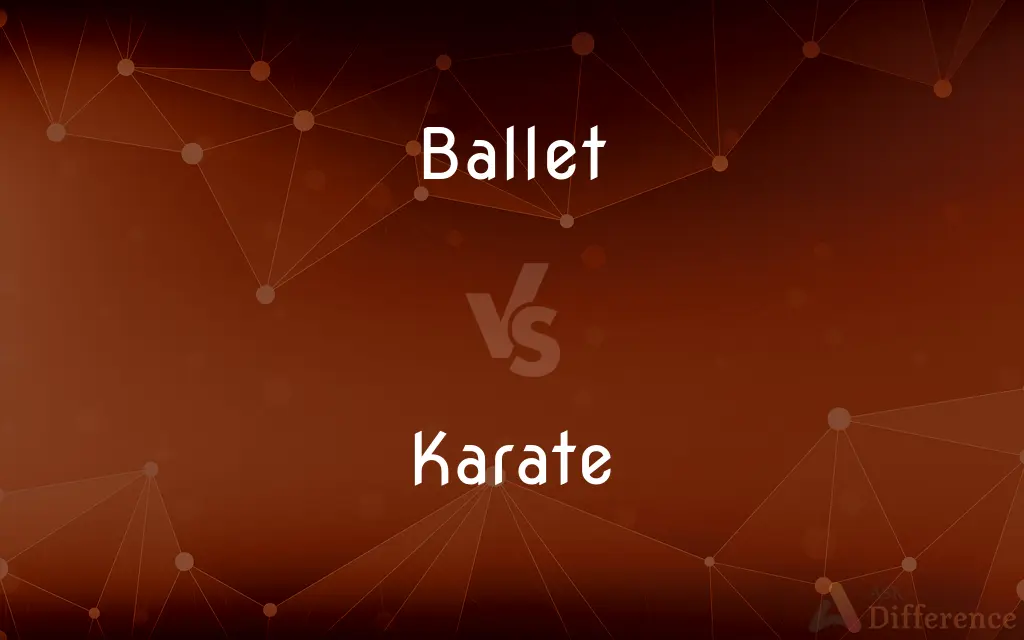Ballet vs. Karate — What's the Difference?
By Urooj Arif & Fiza Rafique — Updated on April 4, 2024
Ballet, a classical dance form characterized by grace, precision, and fluid movements, contrasts sharply with Karate, a martial art known for its discipline, strength, and striking techniques.

Difference Between Ballet and Karate
Table of Contents
ADVERTISEMENT
Key Differences
Ballet, originating from the Italian Renaissance courts of the 15th century, has evolved into a highly technical form of dance with its own vocabulary based on French terminology. It emphasizes aesthetics, fluidity, and storytelling through dance, often performed to classical music. Karate, originating from Okinawa, Japan, blends physical, mental, and moral disciplines, focusing on self-defense through striking, kicking, and defensive blocking with arms and legs.
In ballet, dancers strive for lightness and elegance, often performing on the tips of their toes in pointe shoes. This requires years of training to develop the flexibility, strength, and technique necessary for the demanding performances. Karate practitioners, or karatekas, train to master precise and powerful movements, emphasizing speed, efficiency, and direct impact. The training fosters physical conditioning, focus, and the ability to deliver forceful strikes.
Ballet is performed in theatres and is a major part of the global performing arts culture, with famous works like "Swan Lake" and "The Nutcracker" drawing audiences worldwide. Karate, on the other hand, is practiced in dojos as both a form of self-defense and a competitive sport, recognized worldwide and included in international sports competitions, including the Olympics.
The attire in ballet and karate also reflects their distinct natures. Ballet dancers wear fitted clothing, such as leotards and tutus, allowing for a full range of motion and visibility of their precise movements. Karatekas wear a gi, a loose-fitting white uniform that facilitates free movement for a wide range of techniques and signifies rank through belt colors.
Despite their differences, both ballet and karate require dedication, discipline, and years of practice to master. Each disciplines the body in unique ways and offers its practitioners not only physical benefits but also mental and emotional growth.
ADVERTISEMENT
Comparison Chart
Origin
Italian Renaissance
Okinawa, Japan
Focus
Aesthetics, grace, storytelling
Discipline, strength, self-defense
Technique
Fluid movements, pointe work
Strikes, kicks, blocks
Performance
Theatres, to classical music
Dojos, competitive arenas
Attire
Leotards, tutus
Gi (white uniform), belt
Compare with Definitions
Ballet
Aesthetic Focus.
The aesthetic of ballet is seen in the precise alignment, elegant poses, and seamless transitions between movements.
Karate
Self-Defense.
Karate provides practical self-defense skills, teaching how to respond to various attacks.
Ballet
Global Performing Arts.
The Bolshoi Ballet in Russia is renowned worldwide for its contribution to ballet.
Karate
Competitive Sport.
Karate competitions test skill, speed, and technique in kumite (sparring) and kata (formalized sequences).
Ballet
Fluidity and Grace.
Ballet performances, like Giselle, emphasize expressive movements and emotional storytelling.
Karate
Martial Art.
Karate classes teach self-defense techniques, focusing on strikes and blocks.
Ballet
Classical Dance Form.
Ballet classes focus on developing the technical skills required for classical performances.
Karate
Discipline and Strength.
Karate training emphasizes mental discipline alongside physical strength.
Ballet
Pointe Work.
Dancing en pointe requires strength and balance, with dancers performing on the tips of their toes.
Karate
Olympic Sport.
Karate's inclusion in the Olympics highlights its global recognition and the skill of its practitioners.
Ballet
Ballet (French: [balɛ]) is a type of performance dance that originated during the Italian Renaissance in the fifteenth century and later developed into a concert dance form in France and Russia. It has since become a widespread and highly technical form of dance with its own vocabulary.
Karate
Karate (空手) (; Japanese pronunciation: [kaɾate] (listen); Okinawan pronunciation: [kaɽati]) is a martial art developed in the Ryukyu Kingdom. It developed from the indigenous Ryukyuan martial arts (called te (手), "hand"; tii in Okinawan) under the influence of Kung Fu, particularly Fujian White Crane.
Ballet
A classical dance form characterized by grace and precision of movement and by elaborate formal gestures, steps, and poses.
Karate
A Japanese martial art in which sharp blows and kicks are administered to pressure-sensitive points on the body of an opponent.
Ballet
A theatrical presentation of group or solo dancing to a musical accompaniment, usually with costume and scenic effects, conveying a story or theme.
Karate
An Okinawan martial art involving primarily punching and kicking, but additionally, advanced throws, arm bars, grappling and all means of fighting.
Ballet
A musical composition written or used for this dance form.
Karate
To attack (somebody or something) with karate or similar techniques.
Ballet
A classical form of dance.
A classically-trained ballet dancer
Karate
A traditional Japanese system of unarmed combat; sharp blows and kicks are given to pressure-sensitive points on the body of the opponent.
Ballet
A theatrical presentation of such dancing, usually with music, sometimes in the form of a story.
Let's go to the ballet in the theatre tomorrow!
Karate
A traditional Japanese system of unarmed combat; sharp blows and kicks are given to pressure-sensitive points on the body of the opponent
Ballet
The company of persons who perform this dance.
Zara joined the ballet at the age of 14.
Ballet
(music) A light part song, frequently with a fa-la-la chorus, common among Elizabethan and Italian Renaissance composers.
Ballet
A (small) ball i.e. roundel on a coat of arms, called a bezant, plate, etc., according to colour.
Ballet
(figurative) Any intricate series of operations involving coordination between individuals.
Ballet
To perform an action reminiscent of ballet dancing.
Ballet
An artistic dance performed as a theatrical entertainment, or an interlude, by a number of persons, usually women. Sometimes, a scene accompanied by pantomime and dancing.
Ballet
The company of persons who perform the ballet.
Ballet
A light part song, or madrigal, with a fa la burden or chorus, - most common with the Elizabethan madrigal composers; - also spelled ballett.
Ballet
A bearing in coats of arms, representing one or more balls, which are denominated bezants, plates, etc., according to color.
Ballet
A theatrical representation of a story performed to music by ballet dancers
Ballet
Music written for a ballet
Common Curiosities
Can ballet and karate complement each other?
Yes, ballet's focus on flexibility and grace can complement karate's emphasis on strength and precision, potentially enhancing overall physical performance.
What is the significance of attire in ballet and karate?
Attire in both disciplines is designed to allow for a full range of motion, with ballet attire also highlighting the aesthetics of the dancer's movements.
How do ballet and karate contribute to mental and emotional development?
Both disciplines foster discipline, focus, and persistence, offering mental and emotional benefits such as increased confidence and stress relief.
What cultural significance do ballet and karate hold?
Ballet is a significant part of Western performing arts culture, reflecting historical and cultural narratives. Karate represents a key aspect of Japanese martial arts culture, emphasizing philosophical and ethical values.
What are the main differences between ballet and karate?
Ballet is a dance form focused on grace and storytelling, while karate is a martial art centered on discipline and self-defense.
How do practitioners of ballet and karate train?
Both require rigorous physical training, but ballet focuses on dance techniques and performances, while karate emphasizes combat techniques and sparring.
Are ballet and karate accessible to beginners?
Yes, both fields welcome beginners, with training adapted to introduce fundamental techniques and gradually build up to more advanced levels.
What role does music play in ballet and karate?
In ballet, music is integral to performances, guiding the choreography and emotional tone. In karate, while music is not central to practice, rhythm and timing are important in executing techniques.
How is success measured in ballet and karate?
Success in ballet is often measured by technical proficiency, expressiveness, and roles secured in performances. In karate, progress is marked by belt rankings, proficiency in techniques, and performance in competitions.
How do ballet and karate handle competition and collaboration?
Ballet involves individual and ensemble performances, with competition for roles but also a strong element of collaboration. Karate competitions test individual skill, but training often fosters a sense of community and mutual respect among practitioners.
Share Your Discovery

Previous Comparison
Leaching vs. Extraction
Next Comparison
Passage vs. ParagraphAuthor Spotlight
Written by
Urooj ArifUrooj is a skilled content writer at Ask Difference, known for her exceptional ability to simplify complex topics into engaging and informative content. With a passion for research and a flair for clear, concise writing, she consistently delivers articles that resonate with our diverse audience.
Co-written by
Fiza RafiqueFiza Rafique is a skilled content writer at AskDifference.com, where she meticulously refines and enhances written pieces. Drawing from her vast editorial expertise, Fiza ensures clarity, accuracy, and precision in every article. Passionate about language, she continually seeks to elevate the quality of content for readers worldwide.
















































